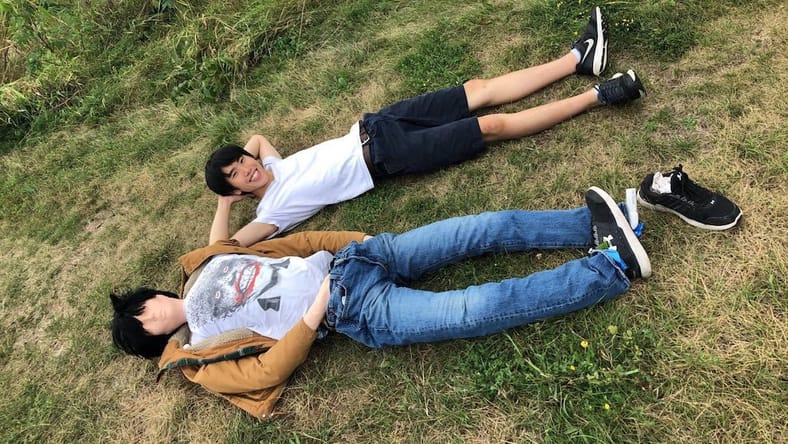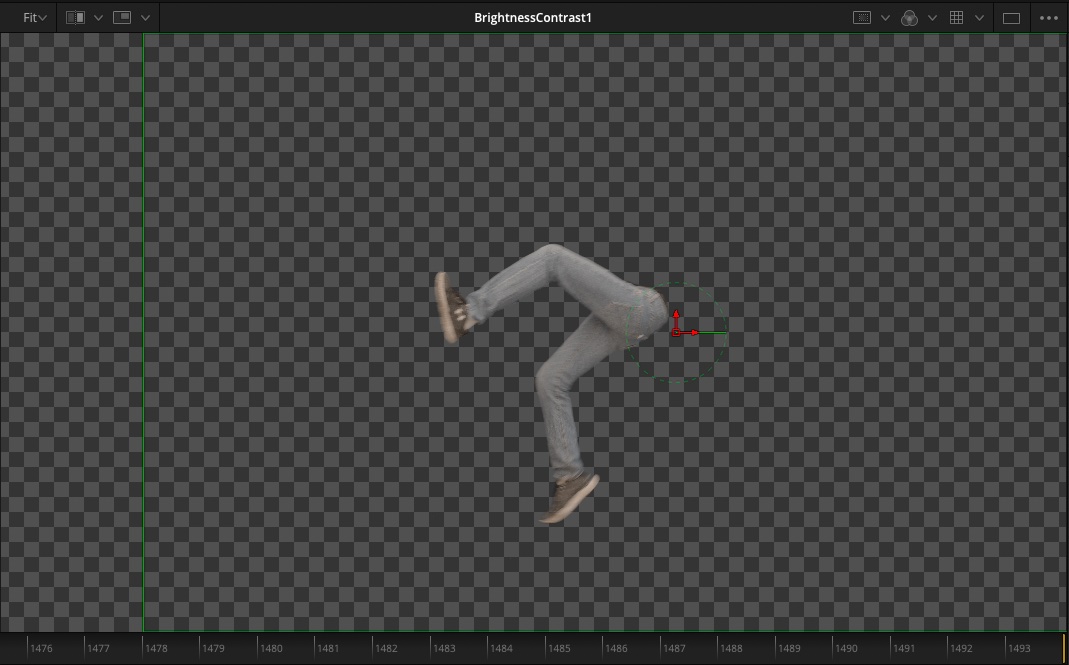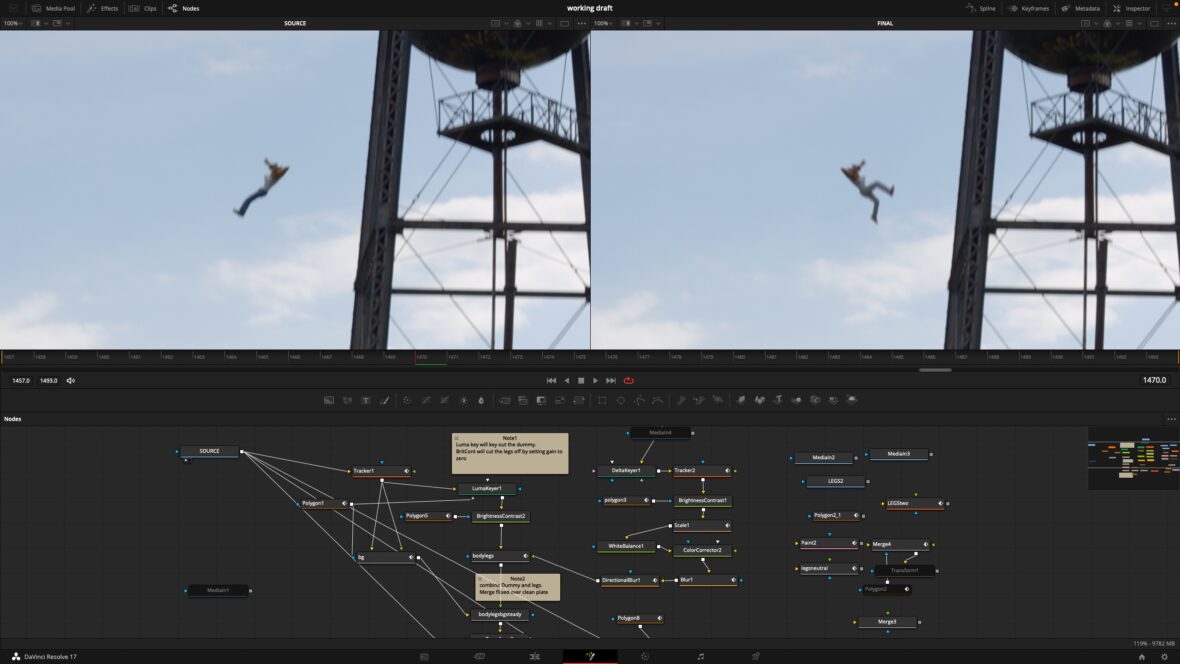
Spoiler warning: The following contains details about the creation of a shocking scene in Therapy Dogs, the debut film from Ethan Eng that is now in theaters and available on-demand. It won Anthony and Joe Russo’s ABGO Fellowship at the 2022 Slamdance Film Festival and is a New York Times Critics Pick.
Not to be too dramatic about it, but Therapy Dogs director Ethan Eng says Steve Roberts and his visual effects program, Fusion, saved his life.
Eng made Therapy Dogs in his senior year of high school, starting in 2019. He had a high-school student budget (he financed the film partly from shifts at McDonald’s), and used his friends and classmates for actors.
He and his co-writer and co-star, Justin Morrice, shot mostly on campus, telling school officials they were just making a yearbook video. They also shot at parties, on old bridges, in a parking lot where Morrice strapped himself to a speeding car, and at an abandoned water tower.
You may have gathered from the speeding-car part that Therapy Dogs has a very familiar relationship with danger. It’s about growing up, but also not wanting to.
Also Read: Ethan Eng Made Therapy Dogs in High School. It’s Spectacular, and the Russo Brothers Noticed
Eng, 21, says he and his friends felt invincible at 17, and took wild risks to prove it. The final year of high school, he says, feels like “your final year of life. Because after that, you’re just this, you know — you think you’re just this adult, and that nobody wants to be an adult when you’re 17. So, yeah, everyone’s just kind of in invincibility mode.”
Hanging heavily over Eng’s senior year in Therapy Dogs is the death of a seemingly happy student at the school, years before the film takes place. The movie addresses the line between feeling invincible, and self-harm. Watching the film, you start to care deeply about the people on screen, and to wish they could be just a little more careful.
Which brings us back to the water tower. At one point, Ethan Eng’s character in the film — we’re never really sure if we’re watching a narrative or a documentary — is hanging out with Morrice at the top of the very tall tower. Morrice very carefully climbs down, and then takes over filming. Eng starts to make his way over a railing, to a very tall ladder, and then —
You gasp.
Eng flails through the air, his legs kicking horribly, and his body thumps to the ground. Did the director of the movie just fall to his death? What the hell just happened? What kind of movie is this?
So… Did Ethan Eng Really Jump From a Water Tower For Therapy Dogs?
Eng didn’t really jump or fall from that water tower, thankfully.
Eng explains.
“Everything we do in the movie in terms of stunts is pretty real. And I didn’t want to chicken out of this one. So I was thinking about it. And I would go to bed some nights and think about how I’m going to pull this off. It was very depressing, actually.
“And we tried thinking of all sorts of things, and everything was, like, stupid. It didn’t work. And part of me just thought, you know, this would make a better story if I just did it.”
At this point the person interviewing Eng utters, “Oh, my God.” Because he’s talking about falling from a huge water tower, and he was just 17 at the time, and not a professional stunt person, and… no.
“Yeah, that’s kind of where my mind was,” says Eng. “But I got really lucky, because I went to a cinema convention.”
One way he had tried to shoot the fall scene was with a mannequin, but it didn’t look real enough for him. So at the convention’s Blackmagic Design booth, Eng approached Roberts.
Roberts and his former company, eyeon Software, first created Fusion back in 1987. It has evolved into a VFX software used in 2D and 3D compositing, virtual reality and motion graphics. Blackmagic acquired it in 2014, and Fusion is now integrated into Blackmagic’s DaVinci Resolve post-production software, available for $295. Roberts is now Fusion’s Product Manager at Blackmagic Design.
Fusion is widely used for compositing, keying, painting, rotoscoping, animation, titling, 3D particle systems, stereoscopic 3D and more, and can be used to composite several elements together to create realistic final images of VFX shots. It’s been used in films ranging from Avatar to Game of Thrones to the Marvel Cinematic Universe to — thank God — Therapy Dogs.
When Eng explained his dilemma, Roberts offered some advice on “how to track and do basic replacement animation,” but also asked Eng to bring the footage to his office the next day, so he could try and do a version of a composite shot.
“Once I saw the footage of the mannequin falling and the freehand tilt of the camera following, I knew I could use Fusion Studio’s tracking tools to track the fall and try some quick animation to make the mannequin not look so stiff,” says Roberts.
He also suggested Eng “try shooting someone on a green screen to incorporate live action, to make it seem more realistic,” he says.

“So, they went off and shot some takes of Ethan hanging from a beam in front of the screen. They sent me the full uncompressed shots, and with more time to refine and incorporate the legs from green screen, all tracked to follow the mannequin, I sent them back the Fusion composition and test movie of the shot, with notes on the process.
“When the film was being finalized, they wanted to change the fall so it looked more like a fall rather than jump, so I tracked and removed the mannequin, flipped that element and composited it back over the water tower shot.”
Or to put it more simply: Eng decided not to risk a very dangerous fall.
“It was like, ‘Oh my God, this man just saved my life with visual effects,’” says Eng. “He literally saved a teenager’s life.”

Things worked out well. Eng’s film got into Slamdance, where it caught the attention of Anthony and Joe Russo, directors of some of those MCU films. He received their $25,000 ABGO Fellowship.
As part of his work for Fusion and Blackmagic, Roberts often works with studios. Helping a first-time filmmaker didn’t take long at all. The final version, he says, took less than an hour to composite.
“It was nice that the young filmmakers reached out and are eager to learn,” he says. “It was a really fun shot to work on.”
Main image: Ethan Eng and his dummy double in Therapy Dogs.
Therapy Dogs is now in theaters.
